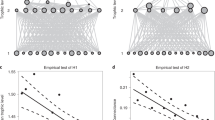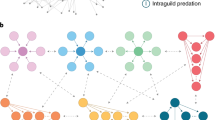Abstract
Global warming threatens community stability and biodiversity around the globe. Knowledge of the mechanisms underlying the responses to rising temperatures depends heavily on generic food-web models that do not account for changes in network structure along latitudes and temperature gradients. Using 124 marine rock-pool food webs sampled across four continents, we show that despite substantial variation in ambient temperature (mean 11.5–28.4 °C), similar empirical food-web and body-mass structures emerge. We have used dynamic modelling to test whether communities from warmer regions are more sensitive to warming and found a general hump-shaped relationship between simulated biodiversity and temperature (gradient from 0–50 °C). This implies that an expected anthropogenic global warming of 4 °C should increase biodiversity in arctic to temperate regions while biodiversity in tropical regions should decrease. Interestingly, simulations of synthetic networks did not yield similar results, which stresses the importance of considering the specificities of natural food webs for predicting community responses to environmental changes.
This is a preview of subscription content, access via your institution
Access options
Access Nature and 54 other Nature Portfolio journals
Get Nature+, our best-value online-access subscription
$29.99 / 30 days
cancel any time
Subscribe to this journal
Receive 12 print issues and online access
$209.00 per year
only $17.42 per issue
Buy this article
- Purchase on Springer Link
- Instant access to full article PDF
Prices may be subject to local taxes which are calculated during checkout





Similar content being viewed by others
Data availability
The data that support the findings of this study are archived in a public repository accessible at: https://doi.org/10.25829/idiv.283-3-756 (ref. 50).
Code availability
The codes used to run the model and to analyse the results are available on Github at https://doi.org/10.5281/zenodo.3578440 (ref. 51).
References
Brose, U. et al. Climate change in size-structured ecosystems. Phil. Trans. R. Soc. B 367, 2903–2912 (2012).
Scheffers, B. R. et al. The broad footprint of climate change from genes to biomes to people. Science 354, aaf7671 (2016).
Ehnes, R. B., Rall, B. C. & Brose, U. Phylogenetic grouping, curvature and metabolic scaling in terrestrial invertebrates. Ecol. Lett. 14, 993–1000 (2011).
Dell, A. I., Pawar, S. & Savage, V. M. Systematic variation in the temperature dependence of physiological and ecological traits. Proc. Natl Acad. Sci. USA 108, 10591–10596 (2011).
Englund, G., Öhlund, G., Hein, C. L. & Diehl, S. Temperature dependence of the functional response. Ecol. Lett. 14, 914–921 (2011).
Jochum, M., Schneider, F. D., Crowe, T. P., Brose, U. & O’Gorman, E. J. Climate-induced changes in bottom-up and top-down processes independently alter a marine ecosystem. Phil. Trans. R. Soc. B 367, 2962–2970 (2012).
Daufresne, M., Lengfellner, K. & Sommer, U. Global warming benefits the small in aquatic ecosystems. Proc. Natl Acad. Sci. USA 106, 12788–12793 (2009).
O’Gorman, E. J. et al. Unexpected changes in community size structure in a natural warming experiment. Nat. Clim. Change 7, 659–663 (2017).
Eklöf, A. et al. The dimensionality of ecological networks. Ecol. Lett. 16, 577–583 (2013).
Binzer, A., Guill, C., Rall, B. C. & Brose, U. Interactive effects of warming, eutrophication and size structure: impacts on biodiversity and food-web structure. Glob. Change Biol. 22, 220–227 (2016).
Schwarz, B. et al. Warming alters energetic structure and function but not resilience of soil food webs. Nat. Clim. Change 7, 895–900 (2017).
Vasseur, D. A. & McCann, K. S. A mechanistic approach for modeling temperature‐dependent consumer‐resource dynamics. Am. Nat. 166, 184–198 (2005).
Petchey, O. L., McPhearson, P. T., Casey, T. M. & Morin, P. J. Environmental warming alters food-web structure and ecosystem function. Nature 402, 69–72 (1999).
Rall, B. C. et al. Universal temperature and body-mass scaling of feeding rates. Phil. Trans. R. Soc. B 367, 2923–2934 (2012).
Binzer, A., Guill, C., Brose, U. & Rall, B. C. The dynamics of food chains under climate change and nutrient enrichment. Phil. Trans. R. Soc. B 367, 2935–2944 (2012).
Williams, R. J. & Martinez, N. D. Simple rules yield complex food webs. Nature 404, 180–183 (2000).
Shurin, J. B., Clasen, J. L., Greig, H. S., Kratina, P. & Thompson, P. L. Warming shifts top-down and bottom-up control of pond food web structure and function. Phil. Trans. R. Soc. B 367, 3008–3017 (2012).
Kéfi, S. et al. Network structure beyond food webs: mapping non-trophic and trophic interactions on Chilean rocky shores. Ecology 96, 291–303 (2015).
Potapov, A. M., Brose, U., Scheu, S. & Tiunov, A. V. Trophic position of consumers and size structure of food webs across aquatic and terrestrial ecosystems. Am. Nat. 194, 823–839 (2019).
Mendonça, V. et al. What’s in a tide pool? Just as much food web network complexity as in large open ecosystems. PLoS ONE 13, e0200066 (2018).
Vucic-Pestic, O., Ehnes, R. B., Rall, B. C. & Brose, U. Warming up the system: higher predator feeding rates but lower energetic efficiencies. Glob. Chang. Biol. 17, 1301–1310 (2011).
Fussmann, K. E., Schwarzmüller, F., Brose, U., Jousset, A. & Rall, B. C. Ecological stability in response to warming. Nat. Clim. Change 4, 206–210 (2014).
Lindeman, R. L. The trophic-dynamic aspect of ecology. Ecology 23, 399–417 (1942).
Lang, B., Ehnes, R. B., Brose, U. & Rall, B. C. Temperature and consumer type dependencies of energy flows in natural communities. Oikos 126, 1717–1725 (2017).
Portalier, S. M. J., Fussmann, G. F., Loreau, M. & Cherif, M. The mechanics of predator–prey interactions: first principles of physics predict predator–prey size ratios. Funct. Ecol. 33, 323–334 (2019).
Ho, H., Tylianakis, J. M., Zheng, J. X. & Pawar, S. Predation risk influences food‐web structure by constraining species diet choice. Ecol. Lett. 22, 1734–1745 (2019).
Brose, U. et al. Predator traits determine food-web architecture across ecosystems. Nat. Ecol. Evol. 3, 919–927 (2019).
Kéfi, S. et al. More than a meal…integrating non-feeding interactions into food webs. Ecol. Lett. 15, 291–300 (2012).
Tylianakis, J. M., Tscharntke, T. & Lewis, O. T. Habitat modification alters the structure of tropical host-parasitoid food webs. Nature 445, 202–205 (2007).
Gauzens, B., Legendre, S., Lazzaro, X. & Lacroix, G. Intermediate predation pressure leads to maximal complexity in food webs. Oikos 125, 595–603 (2016).
Riede, J. O. et al. Scaling of food-web properties with diversity and complexity across ecosystems. Adv. Ecol. Res. 42, 139–170 (2010).
Petchey, O. L., Beckerman, A. P., Riede, J. O. & Warren, P. H. Size, foraging, and food web structure. Proc. Natl Acad. Sci. USA 105, 4191–4196 (2008).
Petchey, O. L., Brose, U. & Rall, B. C. Predicting the effects of temperature on food web connectance. Phil. Trans. R. Soc. B 365, 2081–2091 (2010).
Antiqueira, P. A. P., Petchey, O. L. & Romero, G. Q. Warming and top predator loss drive ecosystem multifunctionality. Ecol. Lett. 21, 72–82 (2018).
Amarasekare, P. Effects of temperature on consumer-resource interactions. J. Anim. Ecol. 84, 665–679 (2015).
Fussmann, K. E., Rosenbaum, B., Brose, U. & Rall, B. C. Interactive effects of shifting body size and feeding adaptation drive interaction strengths of protist predators under warming. Preprint at bioRxiv https://doi.org/10.1101/101675 (2017).
Weinbach, A., Allhoff, K., Thebault, E., Massol, F. & Loeuille, N. Selective effects of temperature on body mass depend on trophic interactions and network position. Preprint at bioRxiv https://doi.org/10.1101/233742 (2017).
Van Der Putten, W. H., Macel, M. & Visser, M. E. Predicting species distribution and abundance responses to climate change: why it is essential to include biotic interactions across trophic levels. Phil. Trans. R. Soc. B 365, 2025–2034 (2010).
Eklöf, A., Kaneryd, L. & Münger, P. Climate change in metacommunities: dispersal gives double-sided effects on persistence. Phil. Trans. R. Soc. B 367, 2945–2954 (2012).
Sentis, A., Binzer, A. & Boukal, D. S. Temperature-size responses alter food chain persistence across environmental gradients. Ecol. Lett. 20, 852–862 (2017).
Tewksburry, J. J., Huey, R. B. & Deutsch, C. A. Putting the heat on tropical animals. Science 320, 1296–1297 (2008).
Dillon, M. E., Wang, G. & Huey, R. B. Global metabolic impacts of recent climate warming. Nature 467, 704–706 (2010).
Digel, C., Curtsdotter, A., Riede, J., Klarner, B. & Brose, U. Unravelling the complex structure of forest soil food webs: higher omnivory and more trophic levels. Oikos 123, 1157–1172 (2014).
Yodzis, P. & Innes, S. Body size and consumer-resource dynamics. Am. Nat. 139, 1151–1175 (1992).
Hirt, M. R., Lauermann, T., Brose, U., Noldus, L. P. J. J. & Dell, A. I. The little things that run: a general scaling of invertebrate exploratory speed with body mass. Ecology 98, 2751–2757 (2017).
Allesina, S., Alonso, D. & Pascual, M. A general model for food web structure. Science 320, 658–661 (2008).
Levine, S. Several measures of trophic structure applicable to complex food webs. J. Theor. Biol. 83, 195–207 (1980).
Lê, S., Josse, J. & Husson, F. FactoMineR: an R package for multivariate analysis. J. Stat. Softw. 25, 1–18 (2008).
Pinheiro, J., Bates, D., DebRoy, S. & Sarkar, D. nlme: Linear and nonlinear mixed effects models. R package version 3.1-143 (2019).
Brose, U. GlobAL daTabasE of traits and food Web Architecture (GATEWAy) version 1.0. iDiv https://doi.org/10.25829/idiv.283-3-756 (2018).
Gauzens, B. The temporal dynamics of intertidal pool communities. Zenodo https://doi.org/10.5281/zenodo.3578553 (2020).
Acknowledgements
B.C.R., U.B. and B.G. acknowledge the support of the German Centre for Integrative Biodiversity Research (iDiv) Halle-Jena-Leipzig funded by the German Research Foundation (FZT 118). C.V. and V.M. acknowledge the project WarmingWebs PTDC/MAR-EST/2141/2012, the research position granted to C.V., the PhD grant SFRH/BD/109618/2015 awarded to V.M. and the strategic project UID/MAR/04292/2019 granted to MARE and UID/Multi/04326/2019 granted to CCMAR, funded by the Portuguese Foundation for Science and Technology. We thank C. Krause for help with the HPC.
Author information
Authors and Affiliations
Contributions
B.G. and U.B. designed the study. V.M. and C.V. collected the data. B.G. wrote the first draft of the manuscript and performed simulations. All authors contributed to the manuscript.
Corresponding author
Ethics declarations
Competing interests
The authors declare no competing interests.
Additional information
Peer review information Nature Climate Change thanks Arnaud Sentis and the other, anonymous, reviewer(s) for their contribution to the peer review of this work.
Publisher’s note Springer Nature remains neutral with regard to jurisdictional claims in published maps and institutional affiliations.
Supplementary information
Supplementary Information
Supplementary Sections 1–8 and Tables 1and 2.
Rights and permissions
About this article
Cite this article
Gauzens, B., Rall, B.C., Mendonça, V. et al. Biodiversity of intertidal food webs in response to warming across latitudes. Nat. Clim. Chang. 10, 264–269 (2020). https://doi.org/10.1038/s41558-020-0698-z
Received:
Accepted:
Published:
Issue Date:
DOI: https://doi.org/10.1038/s41558-020-0698-z
This article is cited by
-
Flexible foraging behaviour increases predator vulnerability to climate change
Nature Climate Change (2024)
-
Modeling time-varying phytoplankton subsidy reveals at-risk species in a Chilean intertidal ecosystem
Scientific Reports (2024)
-
Relationships of temperature and biodiversity with stability of natural aquatic food webs
Nature Communications (2023)
-
Consistent predator-prey biomass scaling in complex food webs
Nature Communications (2022)
-
Some food webs like it hotter
Nature Climate Change (2020)



